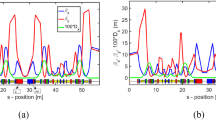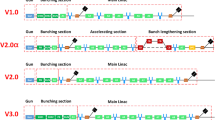Abstract
Purpose
The high energy photon source (HEPS) is a diffraction-limited storage ring light source being built in China. Along with the deeper studies of booster and the evolution of the lattice design and injection scheme of the storage ring, four versions of the booster lattices have been proposed from the project proposal stage.
Methods
Unlike the design of the storage ring, in the booster design, more effort was made to realize stable and reliable operation rather than advanced performance. A FODO structure lattice and the “high-energy accumulation” scheme was adopted in the HEPS booster design. To find the ultimate performance of the lattice, a multi-objective genetic algorithm (MOGA) and particle swarm optimization (PSO) were used to optimize the emittance and the dynamic aperture.
Results
In the latest booster lattice design, the emittance was reduced to 16.3 nm rad. At the same time, the single-bunch charge limit was increased by minimizing the average vertical beta function and reducing the chromaticity.
Conclusions
Through multi iterations with the hardware system, the current lattice was basically frozen and can be used as a basis for related physics studies, hardware and engineering design of the booster. In the future, more detailed physical studies will be performed based on this lattice.






Similar content being viewed by others
References
Y. Jiao et al., Evolution of the lattice design for the high energy photon source, in Proceedings of IPAC’18, Vancouver, Canada (2018), pp. 1363–1366
Y. Jiao et al., The HEPS project. J. Synchrotron Rad. 25, 1611–1618 (2018)
Y. Jiao, F. Chen, P. He et al., Modification and optimization of the storage ring lattice of the High Energy Photon Source. Radiat. Detect. Technol. Methods (2020). https://doi.org/10.1007/s41605-020-00189-7
C. Meng et al., The physics design of the HEPS LINAC. Radiat. Detect. Technol. Methods (2020). https://doi.org/10.1007/s41605-020-00205-w
Project proposal of the High Energy Photon Source, IHEP-HEPS-PO-TR-17-001, Mar. 2017 (in Chinese)
The feasibility report of the High Energy Photon Source, IHEP-HEPS-PO-TR-17-003-R0, Dec. 2017 (in Chinese)
Preliminary design report of the High Energy Photon Source, IHEP-HEPS-PO-TR-18-001-R0, Aug. 2018 (in Chinese)
G. Xu, Y. Jiao, Y. Peng, ESRF-type lattice design and optimization for the high energy photon source. Chin. Phys. C 40(2), 027001 (2016)
G. Xu et al., On-axis beam accumulation enabled by phase adjustment of a double-frequency RF system for diffraction-limited storage rings, in Proceedings of IPAC16, Busan, Korea (2016), pp. 2032–2035
Y.M. Peng et al., Candidate booster design for the HEPS project, in Proceedings of IPAC16, Busan, Korea (2016), pp. 3263–3265
Y. Jiao et al., Candidate lattice design of the HEPS booster consisting of combined-function dipoles, in Proceedings of IPAC2017, Copenhagen, Denmark (2017), pp. 2700–2702
Y.M. Peng et al., The progress of HEPS booster design, in Proceedings of IPAC2017, Copenhagen, Denmark (2017), pp. 1472–1474
Y. Jiao, Improving nonlinear performance of the HEPS baseline design with a genetic algorithm. Chin. Phys. C 40(7), 077002 (2016)
L. Emery, M. Borland, in Proceedings of PAC’03, Portland, OR, USA (2003), pp. 256–258
Y.M. Peng et al., The considerations of improving TMCI threshold on HEPS Booster, in Proceedings of IPAC’18, Vancouver, Canada (2018), pp. 1411–1413
H.S. Xu, N. Wang, The influence of chromaticity on transverse single-bunch instability in the booster of HEPS, in Proceedings of IPAC’18, Vancouver, Canada (2018), pp. 2968–2970
H.S. Xu et al., Studies of the single-bunch instabilities in the booster of HEPS, in Proceedings of IPAC’18, Vancouver, Canada (2018), pp. 2971–2974
Y.M. Peng et al., Status of HEPS booster lattice design and physics studies, in Proceedings of IPAC’18, Vancouver, Canada (2018), pp. 1407–1410
Y. Jiao et al., Accelerator physics studies for the high energy photon source in Beijing, in Proceedings of FLS2018, Shanghai, China, pp. 22–24
J.Y. Li et al., Conceptual design of HEPS injector, in Proceedings of IPAC’18, Vancouver, Canada (2018), pp. 1394–1397
C. Meng et al., Design of bunch lengthening system in electron linac, in Proceedings of IPAC’18, Vancouver, Canada (2018), pp. 1401–1403
Y. Peng, Updates on HEPS injector physics design, Report on the 2nd IAC meeting, Dec. 2019
Acknowledgements
The authors would like to thank our colleagues for the fruitful suggestions and comments. This work is supported by High Energy Photon Source (HEPS), a major national science and technology infrastructure, National Natural Science Foundation of China (Nos. 11805217, 11922512), and Youth Innovation Promotion Association of Chinese Academy of Sciences (No. Y201904).
Author information
Authors and Affiliations
Corresponding author
Rights and permissions
About this article
Cite this article
Peng, Y., Duan, Z., Guo, Y. et al. Design of the HEPS booster lattice. Radiat Detect Technol Methods 4, 425–432 (2020). https://doi.org/10.1007/s41605-020-00202-z
Received:
Revised:
Accepted:
Published:
Issue Date:
DOI: https://doi.org/10.1007/s41605-020-00202-z




